Art Fairs
The FIAC Fair Plunges Back Into Paris, Finding a Market That Is Healthy, If Not So Thirsty for Trophy Works
Some dealers were happier than others with their first-day take.
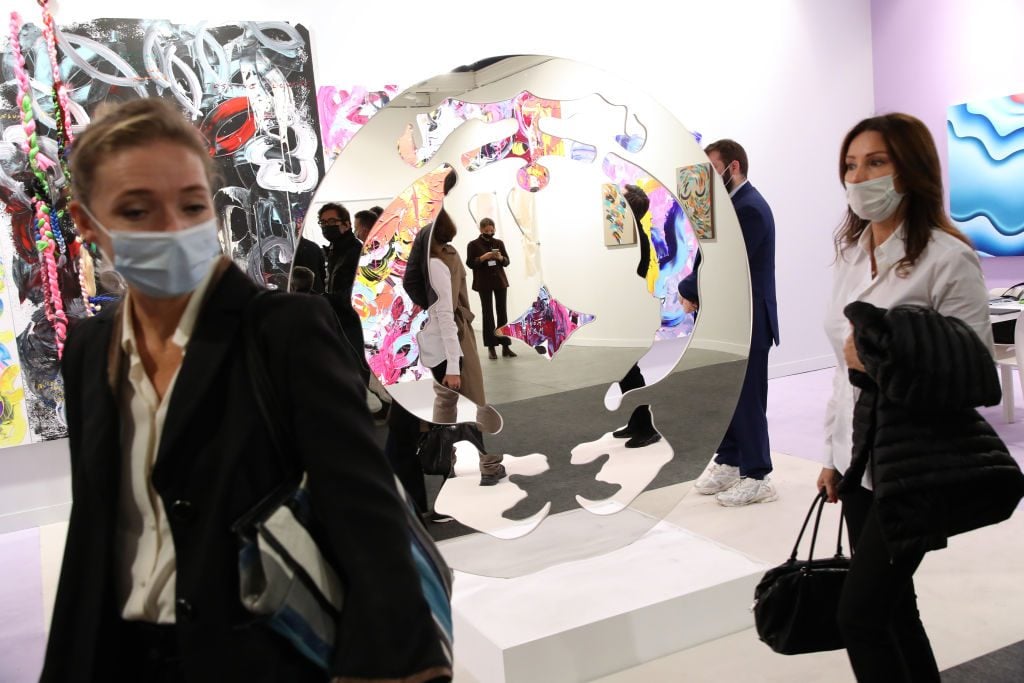
Some dealers were happier than others with their first-day take.

Naomi Rea

You know what everyone was just begging for after the close of two major European art fairs this fall? I’m betting it wasn’t a third one. At least that’s what I was thinking as I grumpily trudged through the rain into the Grand Palais Ephémère—itself a letdown while the original beaux-arts masterpiece undergoes reconstruction—to visit the Foire Internationale d’Art Contemporain (FIAC), my third art bonanza in the span of a month.
But then again, I don’t have many thousands of euros on the line, and for a market that has been bereft of the crucial sales and networking provided by art fairs for effectively two years, most gallerists were eager for the chance to jump straight back into la foule. Some 170 gallerists from 25 countries turned out to FIAC, bright-eyed and bushy-tailed. But the question remained, after an onslaught of fairs and ongoing travel and health concerns: Were their clients still as eager to buy?
“We see different people,” is how Galerie Templon’s general director, Anne-Claudie Coric, put it to me on the bustling opening day. “The people that we see here in FIAC are not the ones we saw at Frieze, they’re not the ones we saw in Basel, and they’re not the ones we saw at Art Paris, earlier in the season.”
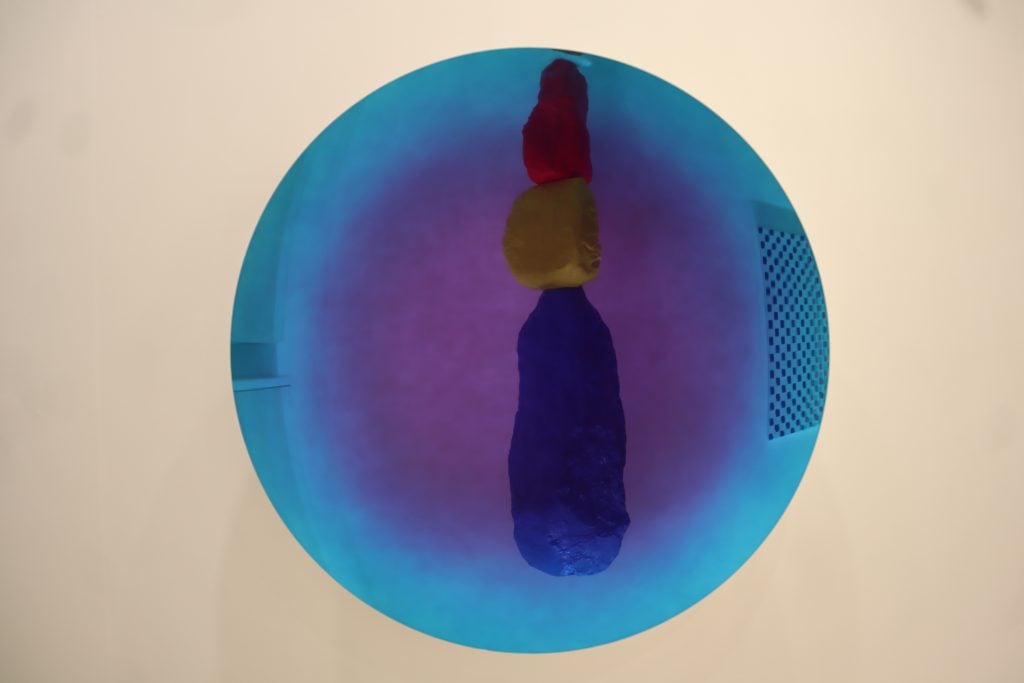
A sculpture by Ugo Rondinone reflected in an Anish Kapoor at Kamel Mennour’s stand at FIAC 2021. Photo by Naomi Rea.
Indeed, turnout was good, with the aisles positively teeming by 11 a.m. American collectors Don and Mera Rubell were one buzzed-about presence; Brad Pitt, who was seen in the early moments of the fair eyeing work by fashion designer Martin Margiela at the booth of Antwerp’s Zeno X, was another. Elsewhere, curators Beatrix Ruf and Chris Dercon, the Moroccan-Canadian comedian Gad Elmaleh, the director and vice president of Louis Vuitton Delphine Arnault, and the billionaire businessman Xavier Niel were spotted roaming the floor of the temporary structure on the Champ de Mars. While the setting was decidedly less glamorous than usual, art advisor Eva Ruiz pointed out that the designers of the building were savvy enough to ensure an unbeatable view of the Eiffel Tower from the champagne lounge—“to remind you you’re in Paris!”
Within a few hours, Templon tallied up 15 sales at all price points, including a $500,000 painting by Kehinde Wiley, a work by Gérard Garouste for €110 000 ($128,000), and one by Senagalese painter Omar Ba for €115,000. Coric said there was “no comparison” to Frieze in terms of sales as well as international collector turnout.
Pre-March 2020, Paris’s formerly stagnant art market had been a undergoing a renaissance, fueled by the rising profile of its art fairs, an influx of U.K. galleries eager to grab a toehold in the European Union post-Brexit, a 49 percent leap in auction sales in 2019, and heavy-hitting new institutions—such as François Pinault’s Bourse de Commerce—breathing new life into the scene. One question on the minds of many at the fair is whether that trajectory will continue.
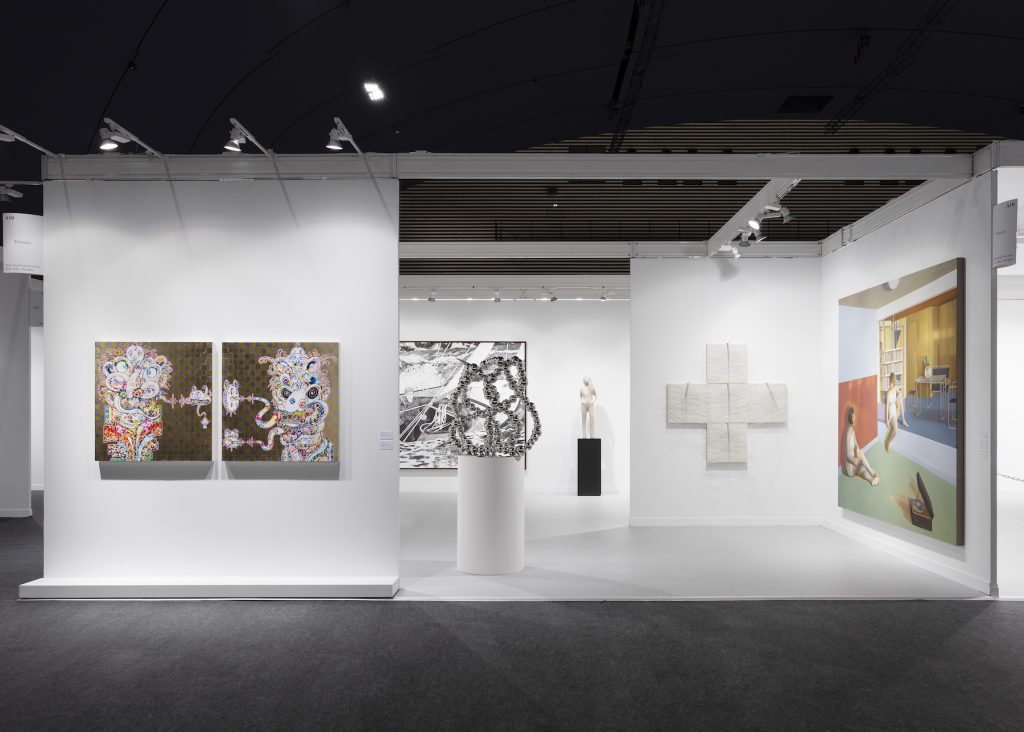
Installation view of Perrotin’s booth at FIAC 2021. Photo: Claire Dorn. Courtesy of the artists and Perrotin.
For his part, Paris-based dealer Kamel Mennour also reported that the Paris art market remained healthy, having had an “extremely positive” experience selling via PDF during the travel hiatus. “There’s a French proverb which says c’est un mal pour un bien, which means ‘something worse for something good,’” he said. In the early hours of the preview, the gallery had sold works priced from €50,000 up to €900,000 ($58,000–$1.05 million). But the dealer added that the crush of fairs this season also meant he needed to be more selective about which to attend, and so skipped the London round last week. “We did Art Paris and Basel, and after that it became a problem for the inventory,” he said.
But other dealers were questioning their bets on Paris becoming the art-market powerhouse of continental Europe. David Zwirner, whose gallery was one of the first international galleries to open in Paris after the Brexit vote, circulated a withering statement mid-afternoon on the first day of the fair. “I am a little disappointed, after the vibrancy of Frieze, with sales at FIAC,” he wrote. “Paris is such a great city for a fair, but FIAC has tended to underperform for us, compared with other major fairs.” Zwirner was hardly coming away empty-handed, though, and said he was “happy” to have sold works by Josef Albers, Francis Alÿs, Harold Ancart, Lucas Arruda, Carol Bove, Oscar Murillo, and Lisa Yuskavage for prices between $100,000 and $400,000.
Despite Zwirner’s tepid take, it is clear that others remain confident in the potential for Paris. Over the past 18 months, several galleries—including Almine Rech, Perrotin, and Gagosian—expanded their existing footprint in the city. Meanwhile, Skarstedt is opening its own space on Avenue Matignon this week to coincide with the fair.
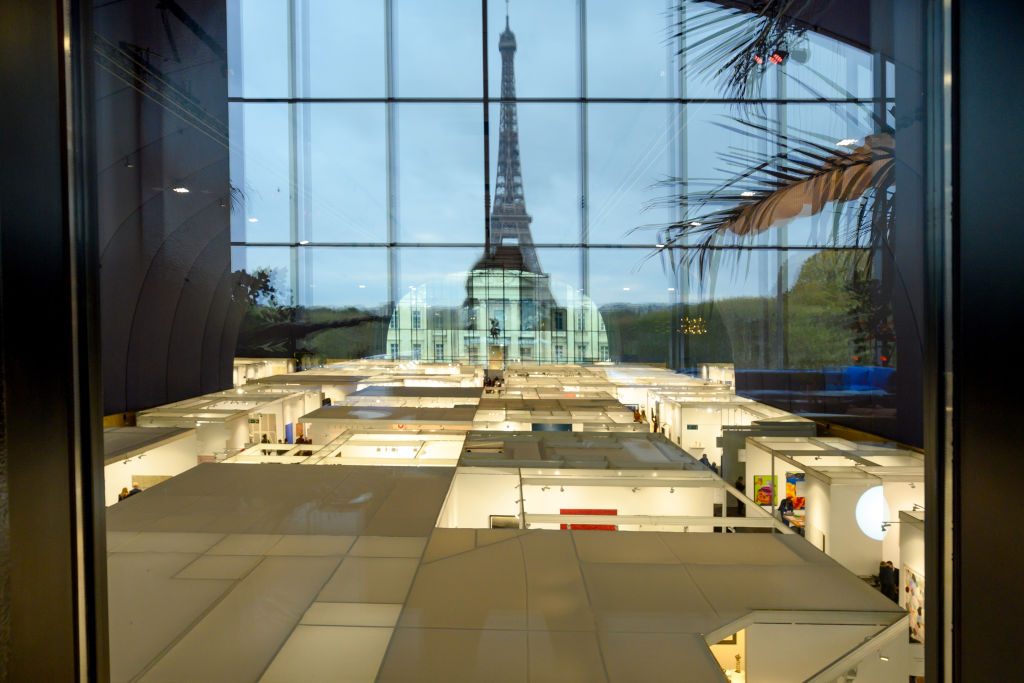
FIAC at Grand Palais Ephemere on October 20, 2021 in Paris, France. (Photo by Bertrand Rindoff Petroff/Getty Images)
On the fair floor, sales were coming in faster than expected, though most often in the lower and middle price brackets. Paris gallerist Édouard Montassut, who was showing paintings by in-demand artist Nora Kapfer, priced between €10,000 and €12,000, admitted that he had actually sold everything ahead of the fair, but was happy to have the chance to showcase her work to the movers and shakers in attendance. One hour in, a representative from Galerie Rosemarie Schwarzwälder nächst St Stephan had sold a Katharina Grosse work on paper for €51,000 ($60,000), and while we were speaking, a bigger painting with sculptural elements was sold from the back room for €240,000 ($280,000). One outlier was a prime-period 1963 Robert Rauschenberg, sold by Thaddaeus Ropac for $2.8 million.
Unlike at Art Basel a month ago, many dealers were happy to see more American collectors in attendance. “I think that has mainly to do with Paris; the institutional shows, the city,” Hauser and Wirth’s president, Marc Payot, who had just flown in from New York, told me. “Americans love Paris, and in the current climate you don’t necessarily come twice or three times to Europe. So you pick where you want to go, or take the risk to go to, and Paris is hard to beat.”
For Payot, sales were not his main priority—as one of the few mega-galleries that does not (to date) have a space in the city, FIAC presents an opportunity to showcase the breadth of Hauser and Wirth’s program: “a brand exercise,” he termed it. By mid-afternoon, the gallery had placed a work by the coveted millennial artist Avery Singer with a French foundation for an undisclosed price, a new George Condo painting for $1.55 million, and a $850,000 Rashid Johnson seascape, bound for a French foundation, among others.
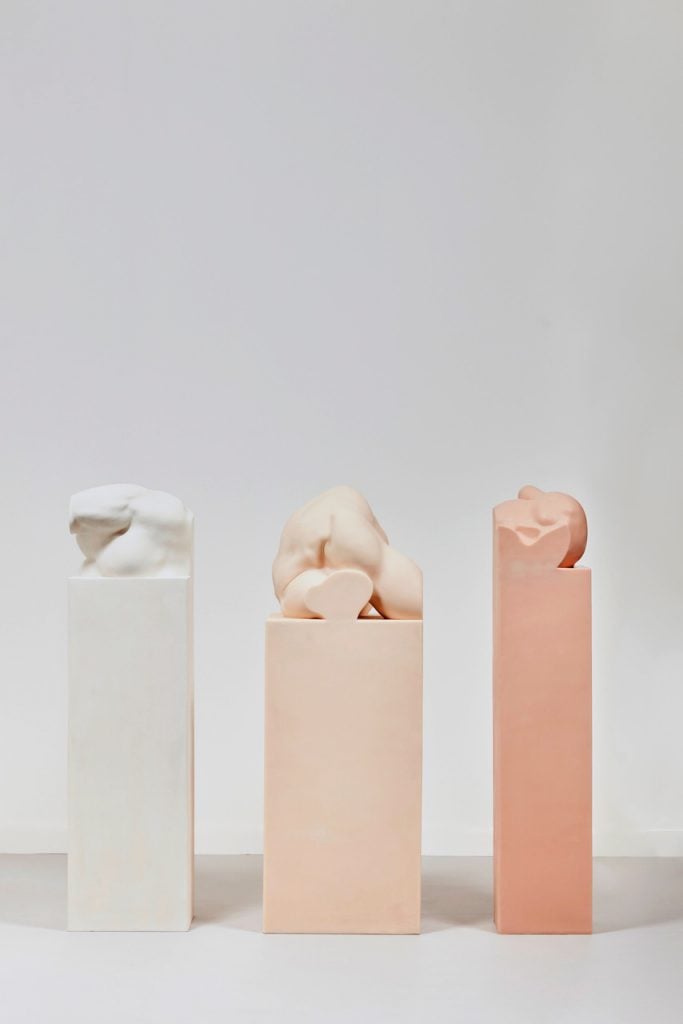
Martin Margiela, Torso I, II, III (2018–21). Photo: Studio Shapiro.
Brad Pitt wasn’t the only party interested in the Margielas at Zeno X. There was heated interest in the secretive artist’s work, which was revealed to the world for the first time at a private opening of his exhibition at Lafayette Anticipations last night. The three sculptures on view at the booth, each an edition of three, were absurdist “torsos” in different shades which recall but do not actually reflect segments of the human figure. In the opening hours of the fair, all three editions of the “pale” silicone torso for €50,000 ($58,000) each, and one of the “medium”-toned ones was placed at €40,000, while the third form—made of plaster—had sold two of the three editions for €45,000 ($52,000) each (at least one museum bought all three versions). The gallery was also offering an edition of red-enameled porcelain fingernails, at €15,000 ($17,500) for the set, in its back room.
“We tried to make a few parallels with the institutional program in Paris,” the gallery’s Nina Hendrickx told me. Facing off on stand is work by Marlene Dumas—currently showing at the Musée d’Orsay—and Luc Tuymans, who is at the Bourse de Commerce. On opening day, this dialogue was paying off, as the gallery had placed a 2013 painting by Tuymans for more than $1 million, and a work on paper by Dumas for north of $150,000.
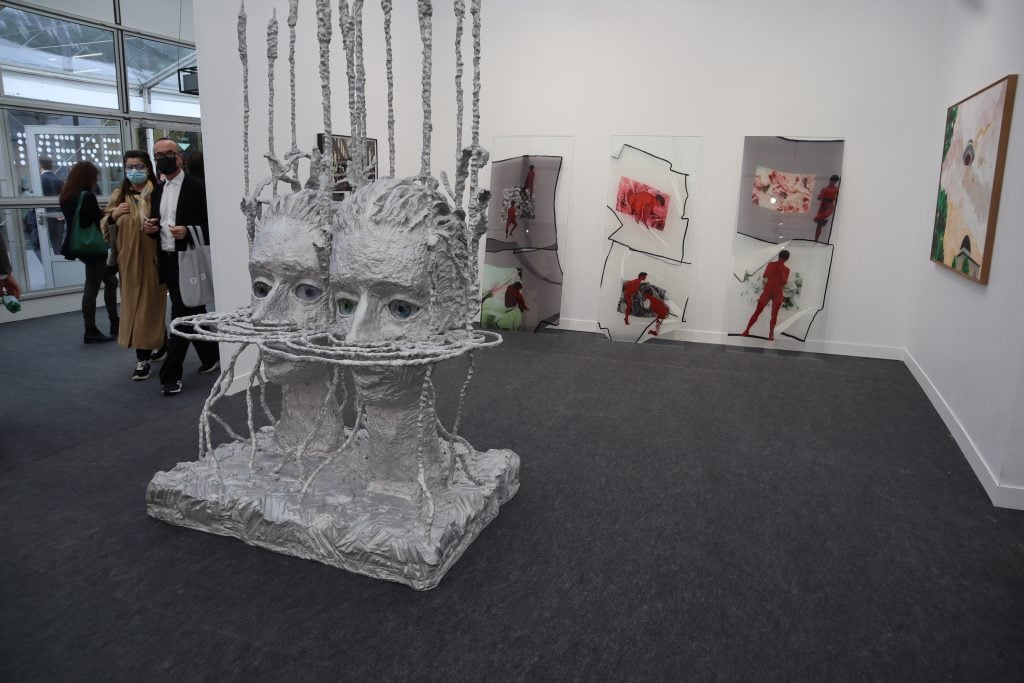
Work by Jean-Marie Appriou and Lili Reynaud-Dewar at Clearing in FIAC 2021. Photo: Naomi Rea.
Conversing with the city’s institutions was a common theme. The Brussels-, New York-, and (as of recently) Beverly Hills-based gallery Clearing was showing, among other things, three works on glass by Lili Reynaud-Dewar, who just won the prestigious Prix Marcel Duchamp and is on view at the Centre Pompidou. By mid-afternoon on the “hectic” opening day, a gallery associate reported all three had sold (€50,000 each) to private collections and an institution. She also noted that they sold more than half the stand, as well as works from the back room, for prices between €6,000 and €200,000 ($7,000–$23,300).
Emmanuel Perrotin, although cramped into a smaller booth than in the Grand Palais, proclaimed he was “very happy” with the temporary space and pace of sales—which for him included several works by Hernan Bas ($150,000–$200,000), as well as pieces by Chen Ke, Jens Fänge, Jean-Michel Othoniel, and Yves Laloy (€20,000– €100,000, or $23,000–$117,000.). “Let’s be patient, but from the beginning, it looks good,” he added. A stalwart of the city’s scene, his gallery did not suffer much from lockdown, despite going from 24 art fairs in 2019 to none overnight: “In my gallery, fairs were not the only moment when we were selling,” he said.
Still, he allowed, “the ecosystem of the art fair is important to meet new people.” So, while his team were on the ground in London for Frieze, Perrotin himself was in Seoul, at KIAF. “I was much more exotic there,” he said. “We met many more people we didn’t know already.”